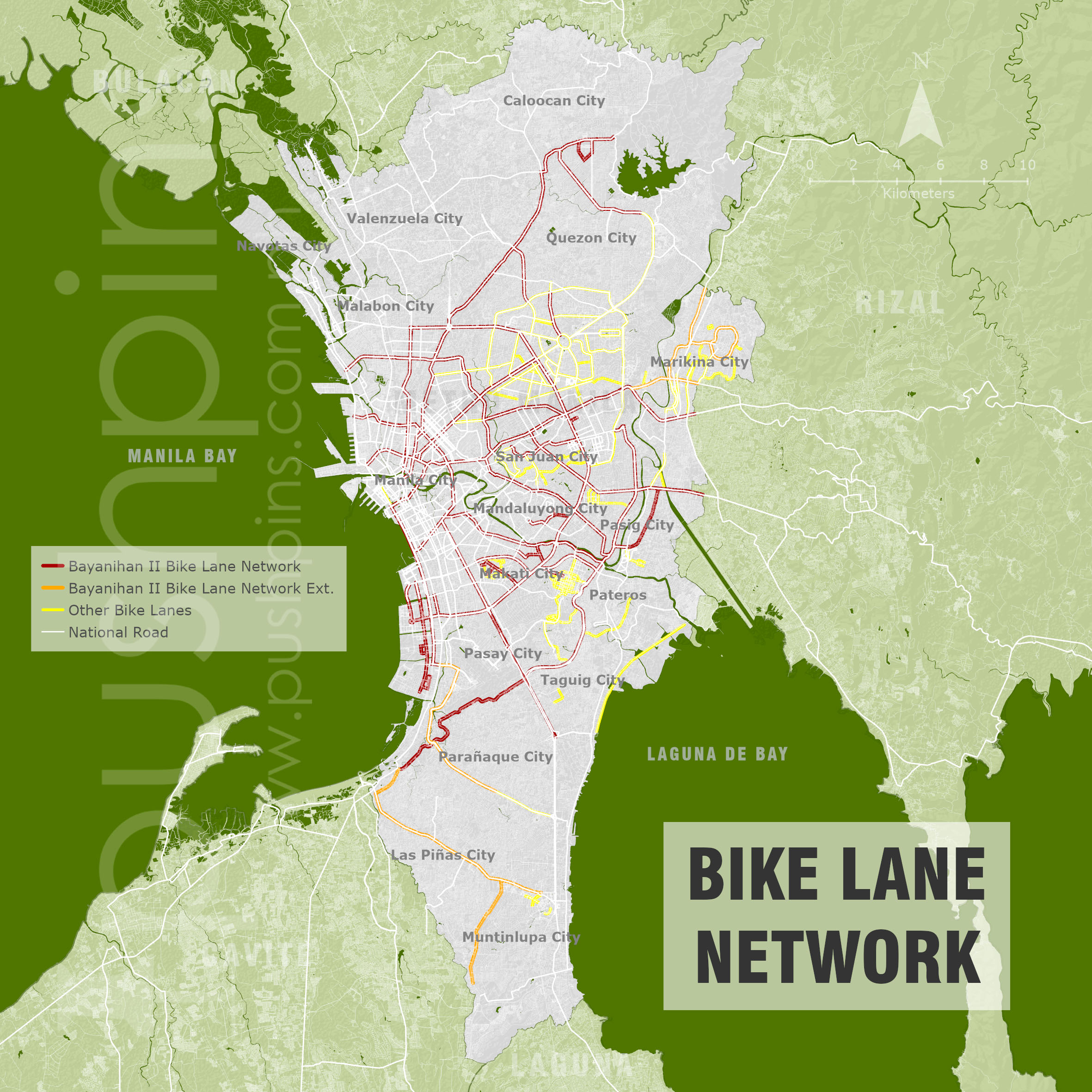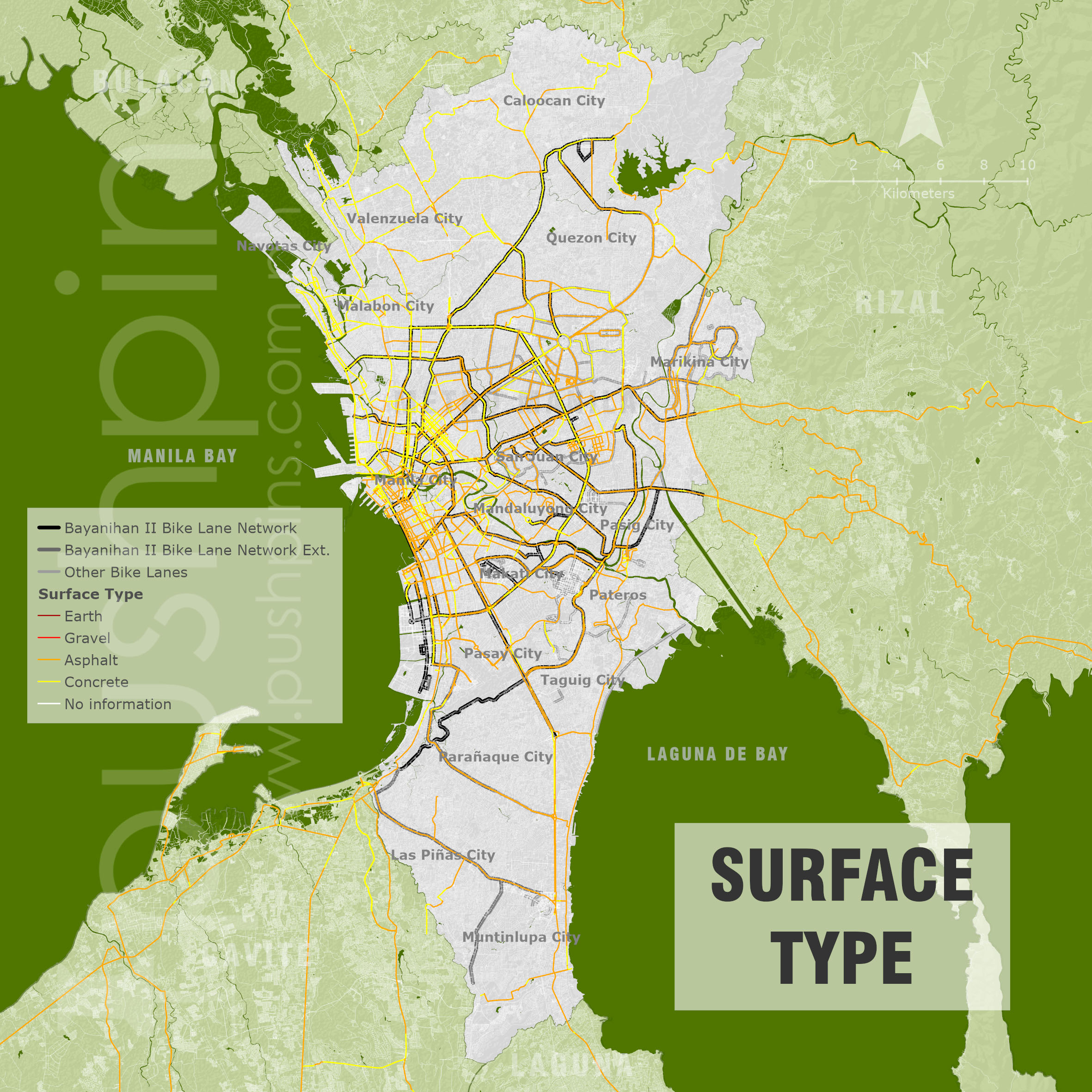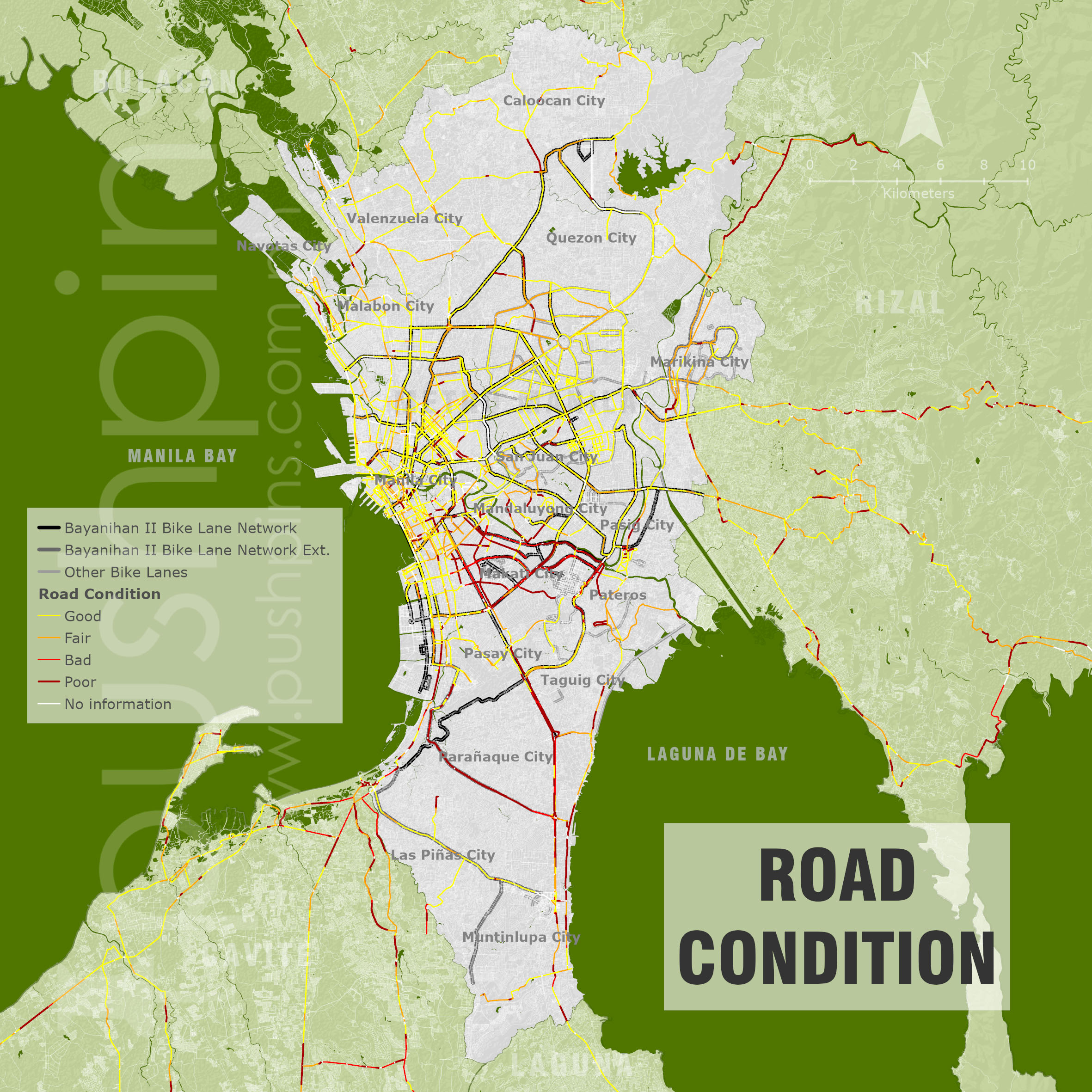The figure above shows Bayanihan II Bike Lane Network along with other bike lane information in Metro Manila that Pushpins has collected so far.
Photo by Pushpins
It was a sight that painted a grim picture of the effects of the lockdown: throngs of people were left stranded on the streets, with no clear way to travel from one place to another. Some were forced to walk hundreds of kilometers to earn their daily wages or get to a hospital for urgent medical checkups.
The pandemic has clearly underscored the need for alternative modes of transportation. As lockdown restrictions were strictly imposed, a small portion of the population resorted to biking around Metro Manila primarily to get to and from work.
Photojournalist Jilson Tiu took to cycling so he can continue documenting the streets. “The best thing about cycling in the city is that you can hit multiple locations while giving you a sense of freedom during the community quarantine,” he relates. “The city unfolds before your eyes as you kick the pedal. You burn fat instead of fossil fuel.”
Aside from health benefits, cycling also comes with economic advantages. A study in Toronto, Canada, for instance, points to an increase in spending and number of customers, benefiting retail and food establishments on a street with bike lanes. So why aren’t many people in the Philippines pedaling? What will it take to encourage Filipinos to consider cycling as a good alternative to get around?
A bumpy road
In a country where people generally regard cycling as a hobby, biking around the metro isn’t as easy as picking up a bike from a shop. Numerous hurdles had to be addressed to encourage more people to get on a bike.
Among these challenges is the lack of proper infrastructure such a bike lanes and parking, says urban planner and Life Cycles PH founder Keisha Mayuga, citing a June 2021 World Bank study (unpublished as of this writing). Mayuga, who established Life Cycles PH as a movement that provides bicycles to essential workers, relates, “For a lot of people who started cycling in the pandemic, biking has become their main mode of transportation. Because there were so many new cyclists, the boom also demanded for better cycling infrastructure to keep these new cyclists safe. Cycling is also a great form of transport in mitigating the spread of COVID-19 because it practices physical distancing and cyclists have good ventilation in the open air.”
But isn’t it too hot to bike around the city? “Though I do agree that it gets hot, a lot of the heat actually also comes from vehicle exhaust. The secret to a cool ride is to keep moving,” replies Mayuga, who, apart from walking, has made cycling her primary mode of transportation since 2015.
A network of connectivity
July 2021 saw the opening of the Metro Manila bike lane network, a 313-kilometer of interconnected lanes that span 12 cities. Life Cycles PH, along with other organizations like the Move As One Coalition, Bikers United Marshalls, and other cycling groups, helped expedite the creation of a linked network of bike lanes by prodding the concerned agencies to act swiftly. “The will from different agencies and sectors of government—the senate, the congress, national government agencies like DOTr (Department of Transportation), DOH (Department of Health), DILG (Department of Interior and Local Government), and DPWH (Department of Public Works and Highways)—grew, and citizens started clamoring for something to happen. That’s how a small 1.3km-long pop-up finally became the bike lanes we know today,” Mayuga details.
Tiu commends the bikes lanes in Bonifacio Global City, Makati City, and a few ones along EDSA. He says these lanes are wide enough to accommodate cyclists pedaling side-by-side on either direction. However, Tiu adds that roads along Quezon Avenue and Aurora Boulevard in Quezon City need more improvement to accommodate waiting sheds and ample sidewalks for pedestrians.
Safety first
Putting up bike lanes is one thing; enticing cyclists to use them is another. To do this, bikers should be assured of road safety before they even get on their bikes.
Imposing speed limits on shared roads tops Mayuga’s list of cycling non-negotiables. Whether you are in a car or on a bike, slower speed makes for safer roads as most road accidents are caused by speeding vehicles. “By lowering the speed limit to 30kph on many roads, the chance of fatality lowers by a lot. I also like to say that on some roads that are too narrow for bike lanes, low speed limits are enough to make it safer for cyclists and pedestrians,” she explains.
The figure above shows the bike lanes overlaid with the DPWH data on the number of vehicle lanes of national roads.
Physical barriers as well as visible signages are also crucial. Adds the Life Cycles PH founder, “The rule of thumb for road safety is to not mix different masses and different speeds.” Bollards, planters, and trees, for example, are effective ways to physically separate various road users. If vehicles running at 60kph share the road with cyclists, then physical barriers should be more visible (e.g., elevated bike lanes). “Having a well-lit bicycle lane is especially helpful for road users at night. Thermoplastic paint to clearly mark bike lanes is also a good way to communicate to road users that there is a bike lane present.”
Finding solutions to road obstructions, such as parked cars, potholes, uneven paths, and flooding should also be prioritized. Tiu recalls how unpaved and rough roads in Metro Manila prompted him to switch to thicker tires.
The figures above show the bike lanes overlaid with the DPWH data on the surface type and condition of national roads.
More importantly, adopting behavior that respects all road users ensures the safety of not only cyclists but also motorists and pedestrians. “We have to understand that the road is built for people to move, so we have to respect one another no matter what transport mode we choose,” states Mayuga. Tiu agrees, recalling his encounters with inconsiderate drivers. “Sharing the road, I think, is possible with proper road etiquette…Education [also] plays a big role [in having] safe roads.”
Beyond the movement
Sustaining cycling as a viable means of transportation doesn’t end with the creation of bike lanes. It’s a continuous effort on the part of the national government in close collaboration with local government units as well as cyclists. This requires government agencies to allot budget specifically for the maintenance and expansion of bike lane networks for better interconnectivity. Policies on cycling and road safety should also be put in place.
For those planning to pedal around the city, Tiu recommends getting a gravel or commuter bike with thick tires and fenders for easier mobility. “Invest in a good brand so that in the future, you would not need to change frames if ever you want to change your components. Also, before you hit the road, please look up and study road rules to be safe. You need a lot of patience dealing with bad roads and bad drivers in the metro,” he adds.
As more and more people take to cycling, communities will benefit in the long run. “When a person decides to bike, [he or she is] deciding to be one less car on the road or one more seat in the bus for other people who can’t bike,” says Mayuga. One less car plying the streets means less pollution; and less pollution, in turn, creates more livable cities that paint a more sustainable future.
—
Basemap data © OpenStreetMap contributors
All information presented here are based on available data and are only meant for an overview of the subject. For in-depth analyses, an extensive study is necessary.
Pushpins is a GIS company in the Philippines. For more information on how we can help your organization, log on here.




